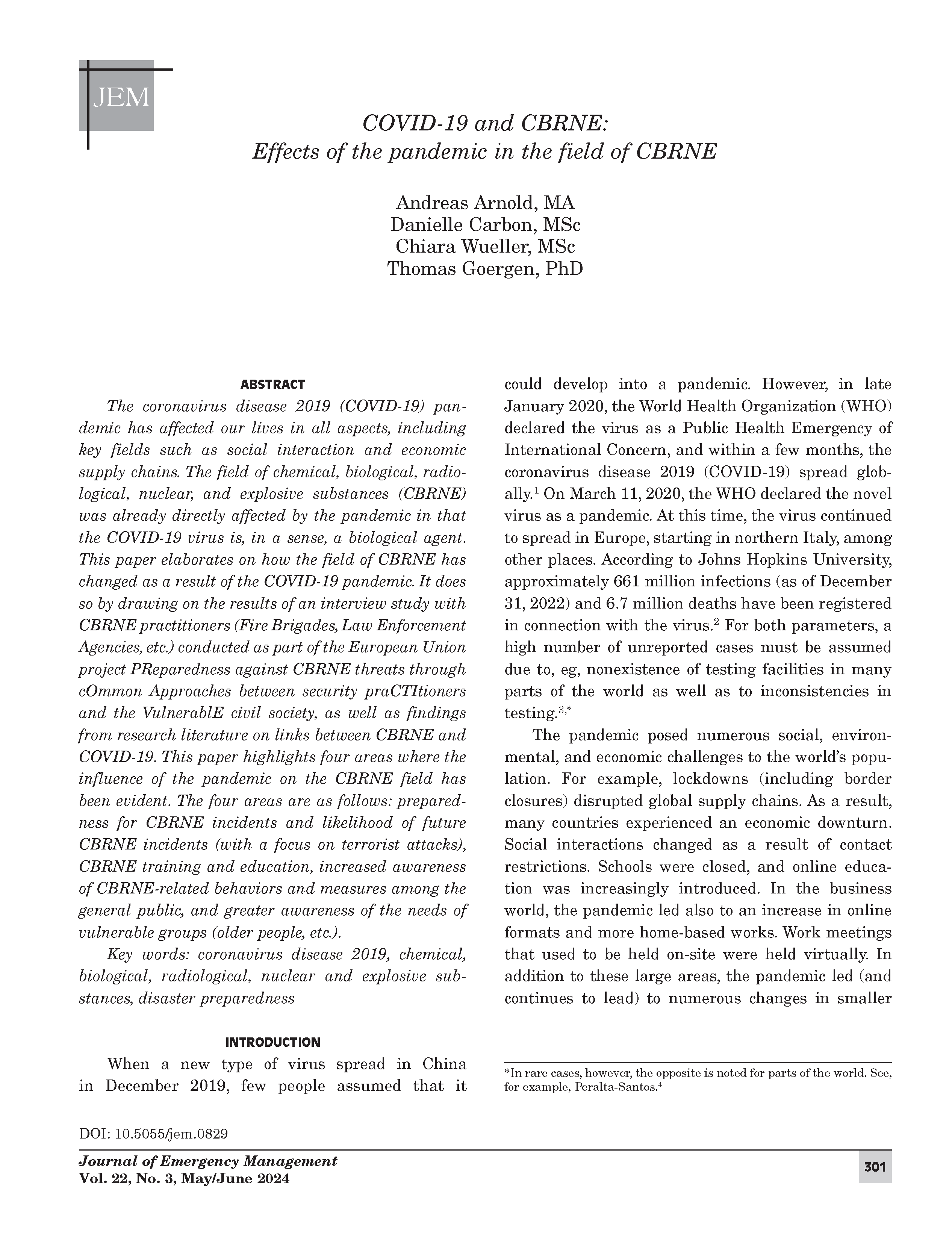COVID-19 and CBRNE: Effects of the pandemic in the field of CBRNE
DOI:
https://doi.org/10.5055/jem.0829Keywords:
coronavirus disease 2019, chemical, biological, radiological, nuclear and explosive substances, disaster preparednessAbstract
The coronavirus disease 2019 (COVID-19) pandemic has affected our lives in all aspects, including key fields such as social interaction and economic supply chains. The field of chemical, biological, radiological, nuclear, and explosive substances (CBRNE) was already directly affected by the pandemic in that the COVID-19 virus is, in a sense, a biological agent. This paper elaborates on how the field of CBRNE has changed as a result of the COVID-19 pandemic. It does so by drawing on the results of an interview study with CBRNE practitioners (Fire Brigades, Law Enforcement Agencies, etc.) conducted as part of the European Union project PReparedness against CBRNE threats through cOmmon Approaches between security praCTItioners and the VulnerablE civil society, as well as findings from research literature on links between CBRNE and COVID-19. This paper highlights four areas where the influence of the pandemic on the CBRNE field has been evident. The four areas are as follows: preparedness for CBRNE incidents and likelihood of future CBRNE incidents (with a focus on terrorist attacks), CBRNE training and education, increased awareness of CBRNE-related behaviors and measures among the general public, and greater awareness of the needs of vulnerable groups (older people, etc.).
References
*Shaw R, Kim Y, Hua J: Governance, technology and citizen behavior in pandemic: Lessons from COVID-19 in East Asia. Progress Disaster Sci. 2020; 6: 100090. DOI: 10.1016/j.pdisas.2020.100090. DOI: https://doi.org/10.1016/j.pdisas.2020.100090
Johns Hopkins University: Coronavirus resource center. Available at https://coronavirus.jhu.edu/. Accessed December 31, 2022.
*Wankmüller C: European disaster management in response to the COVID-19 pandemic. Mind Soc. 2021; 20: 165-170. DOI: 10.1007/s11299-020-00252-2. DOI: https://doi.org/10.1007/s11299-020-00252-2
Peralta-Santos A: Assessment of COVID-19 surveillance case definitions and data reporting in the European union. Policy Department for Economic, Scientific and Quality of Life policies, Directorate-General for internal policies. Available at https://www.europarl.europa.eu/RegData/etudes/BRIE/2020/652725/IPOL_BRI(2020)652725_EN.pdf. Accessed June 22, 2023.
Ng K, Lean M: The Fukushima nuclear crisis reemphasizes the need for improved risk communication and better use of social media. Health Phys. 2012; 103(3): 307-310. DOI: 10.1097/HP.0b013e318257cfcb. DOI: https://doi.org/10.1097/HP.0b013e318257cfcb
Okumura T, Hisaoka T, Yamada A, et al.: The Tokyo subway sarin attack—Lessons learned. Toxicol Appl Pharmacol. 2005; 207(2): 471-476. DOI: 10.1016/j.taap.2005.02.032. DOI: https://doi.org/10.1016/j.taap.2005.02.032
Haslam JD, Russell P, Hill S, et al.: Chemical, biological, radiological, and nuclear mass casualty medicine: A review of lessons from the Salisbury and Amesbury Novichok nerve agent incidents. Br J Anaesth. 2021; 128(2): E200-E205. DOI: 10.1016/j.bja.2021.10.008. DOI: https://doi.org/10.1016/j.bja.2021.10.008
*Silke A: COVID-19 and terrorism: Assessing the short-and long-term impacts. Available at https://www.poolre.co.uk/solutions/riskawareness/covid-19-and-terrorism-report/. Accessed August 4, 2022.
*Rimpler-Schmid A, Trapp R, Leonard S, et al.: EU Preparedness and Responses to Chemical, Biological, Radiological and Nuclear (CBRN) Threats. Brussels: European Parliament, 2021. DOI: 10.2861/857738.
*Bakker C, Farina A: Response and recovery related to naturally occurring CBRN events: Focusing on epidemic outbreaks, including COVID-19. In Guttry A, Casolari F, Frulli M (eds.): International Law and Chemical, Biological, Radio-Nuclear (CBRN) Events. Leiden: Koninklijke Brill, 2022: 294-307. DOI: https://doi.org/10.1163/9789004507999_019
Arnold A, Carbon D, Görgen T, et al.: Final report on common approaches of CBRNe practitioners. PROACTIVE deliverable D2.5. Available at https://proactive-h2020.eu/. Accessed February 7, 2023.
Arnold A, Carbon D, Siemens M, et al.: Report on the survey and benchmarking results. PROACTIVE deliverable D2.3. Available at https://proactive-h2020.eu/. Accessed February 7, 2023.
*Anson S, Bertel D, Havârneanu G, et al.: Inclusive communication in times of crisis: Lessons learned and recommendations from COVID-19 and other CBRNe incidents based on recent COVINFORM & PROACTIVE findings. Whitepaper. Available at https://bit.ly/3me4Utz. Accessed February 7, 2023.
*Bentz J: Learning from catastrophe: Lessons from the COVID-19 pandemic for preparing for and responding to a domestic radiation emergency. NTI Paper. Available at https://www.nti.org/analysis/articles/learning-from-catastrophe-lessons-from-the-covid-19-pandemic-for-preparing-for-and-responding-to-a-domestic-radiation-emergency/. Accessed February 7, 2023.
Ward P: COVID-19: Supplies just-in-time or just-too-late? Available at https://fisher.osu.edu/blogs/opex/2020/04/22/covid19-supplies-just-in-time-or-just-too-late. Accessed June 22, 2023.
Barocas J, Gounder C, Madad S: Just-in-time versus just-in-case pandemic preparedness. Available at https://www.healthaffairs.org/content/forefront/just-in-time-versus-just-in-case-pandemic-preparedness. Accessed June 22, 2023.
*Brzozowski A: Has COVID-19 increased the threat of bioterrorism in Europe? Available at https://www.euractiv.com/section/defence-and-security/news/has-covid-19-increased-the-threat-of-bioterrorism-in-europe/. Accessed August 9, 2022.
*Ackerman G, Peterson H: Terrorism and COVID-19. Actual and potential impact. Perspect Terror. 2020; 14(3): 59-73.
*Kadivar J: Daesh and the power of media and message. Available at https://www.arabmediasociety.com/daesh-and-thepower-of-media-and-message/. Accessed August 9, 2022.
*Michalski A, Knap J, Bielawska-Drózd A, et al.: Lessons learned from 2001-2021 – from the bioterrorism to the pandemic era. Ann Agric Environ Med. 2022; 29(1): 1-11. DOI: 10.26444/aaem/146604. DOI: https://doi.org/10.26444/aaem/146604
*Tin D, Sabeti P, Ciottone GR: Bioterrorism: An analysis of biological agents used in terrorist events. Am J Emerg Med. 2022; 54: 117-121. DOI: 10.1016/j.ajem.2022.01.056. DOI: https://doi.org/10.1016/j.ajem.2022.01.056
*Meyer C, Besch S, Bricknell M, et al.: How the COVID-19 crisis has affected security and defence-related aspects for the EU. Available at https://www.europarl.europa.eu/thinktank/en/document/EXPO_IDA(2021)653623. Accessed February 7, 2023.
*Potutan G, Arakida M: Evolving disaster response practices during COVID-19 pandemic. Int J Environ Res Public Health. 2021; 18: 3137. DOI: 10.3390/ijerph18063137. DOI: https://doi.org/10.3390/ijerph18063137
*Smith JA, Judd J: COVID-19: Vulnerability and the power of privilege in a pandemic. Health Prom J Aust. 2020; 31: 158-160. DOI: 10.1002/hpja.333. DOI: https://doi.org/10.1002/hpja.333
*UNDRR Asia-Pacific: COVID-19 brief: Leave no one behind in COVID-19 prevention, response and recovery. Available at https://www.undrr.org/publication/undrr-asia-pacific-covid-19-brief-leaveno-one-behind-covid-19-prevention-response-and. Accessed August 4, 2022.
*Ashraf A: Lessons learned from COVID-19 response for disaster risk management. Nat Hazards. 2021; 107: 2027-2032. DOI: 10.1007/s11069-021-04658-0. DOI: https://doi.org/10.1007/s11069-021-04658-0
*Lauvrak V, Juvet L: Social and Economic Vulnerable Groups during the COVID-19 Pandemic. Rapid Review. Oslo: Norwegian Institute of Public Health, 2020.
*Antunes D, Palma-Oliveira J: A glimpse of the lessons learned during the COVID-19 pandemic. Bi-monthly report 3, COVINFORM H2020 Project No. 101016247. Available at https://www.covinform.eu/knowledge-repository/communication-misinformation/. Accessed February 8, 2023.
*Ackerman G, Kallenborn Z, Bleek P: Going viral: Implications of COVID-19 for bioterrorism. CTC Sentinel. 2022; 15(5): 1-12.

Published
How to Cite
Issue
Section
License
Copyright 2007-2025, Weston Medical Publishing, LLC and Journal of Emergency Management. All Rights Reserved.





